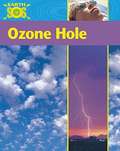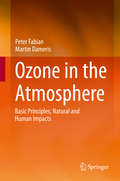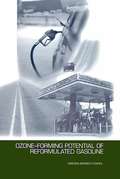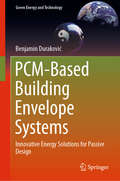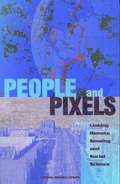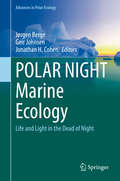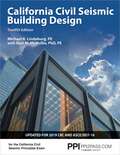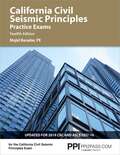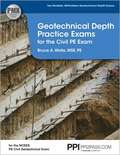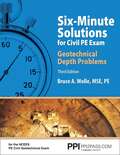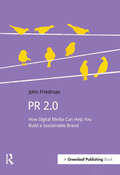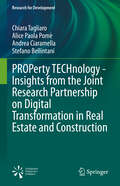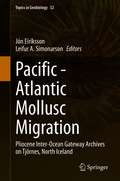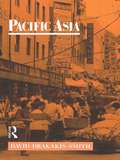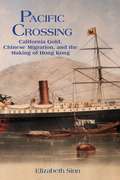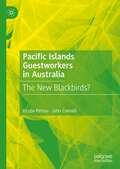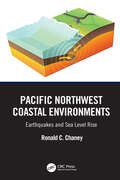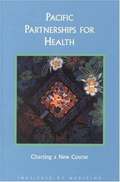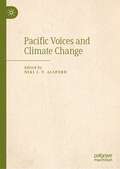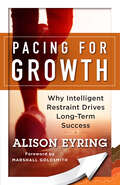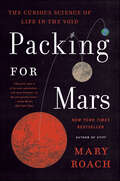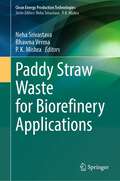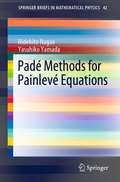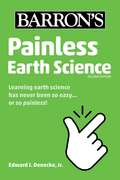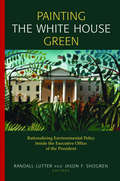- Table View
- List View
Ozone Hole (Earth SOS)
by Sally MorganOffering information at multiple levels for several reading levels, this series describes the many dimensions of the ozone hole and related problems that accompany global warming and mankind's abuse of the environment. The interdependence of all the natural systems in the world are stressed in the book. This volume concludes with a fact file and suggestions for the reader on how to improve the environment.
Ozone in the Atmosphere
by Peter Fabian Martin DamerisPeter Fabian and Martin Dameris provide a concise yet comprehensive overview of established scientific knowledge about ozone in the atmosphere. They present both ozone changes and trends in the stratosphere, as well as the effects of overabundance in the troposphere including the phenomenon of photosmog. Aspects such as photochemistry, atmospheric dynamics and global ozone distribution as well as various techniques for ozone measurement are treated. The authors outline the various causes for ozone depletion, the effects of ozone pollution and the relation to climate change. The book provides a handy reference guide for researchers active in atmospheric ozone research and a useful introduction for advanced students specializing in this field. Non-specialists interested in this field will also profit from reading the book. Peter Fabian can look back on a life-long active career in ozone research, having first gained international recognition for his measurements of the global distribution of halogenated hydrocarbons. He also pioneered photosmog investigations in the metropolitan areas of Munich, Berlin, Athens and Santiago de Chile, and his KROFEX facility provided controlled ozone fumigation of adult tree canopies for biologists to investigate the effects of ozone increases on forests. Besides having published a broad range of scientific articles, he has also been the author or editor of numerous books. From 2002 to 2005 he served the European Geosciences Union (EGU) as their first and Founding President. Martin Dameris is a prominent atmospheric modeler whose interests include the impacts of all kinds of natural and man-made disturbances on the atmospheric system. His scientific work focuses on the connections between ozone and climate changes. For many years he has been an active contributor to the WMO scientific ozone depletion assessments, which have been used to monitor the depletion and recovery of the ozone layer in accordance with the Montreal Protocol.
Ozone-Forming Potential of Reformulated Gasoline
by National Research CouncilThe National Academies Press (NAP)--publisher for the National Academies--publishes more than 200 books a year offering the most authoritative views, definitive information, and groundbreaking recommendations on a wide range of topics in science, engineering, and health. Our books are unique in that they are authored by the nation's leading experts in every scientific field.
PCM-Based Building Envelope Systems: Innovative Energy Solutions for Passive Design (Green Energy and Technology)
by Benjamin DurakovićPCM Enhanced Building Envelopes presents the latest research in the field of thermal energy storage technologies that can be applied to solar heating and cooling with the aim of shifting and reducing building energy demand. It discusses both practical and technical issues, as well as the advantages of using common phase change materials (PCMs) in buildings as a more efficient, novel solution for passive solar heating/cooling strategies. The book includes qualitative and quantitative descriptions of the science, technology and practices of PCM-based building envelopes, and reflects recent trends by placing emphasis on energy storage solutions within building walls, floors, ceilings, façades, windows, and shading devices. With the aim of assessing buildings’ energy performance, the book provides advanced modeling and simulation tools as a theoretical basis for the analysis of PCM-based building envelopes in terms of heat storage and transfer. This book will be of interest to all those dealing with building energy analysis such as researchers, academics, students and professionals in the fields of mechanical and civil engineering and architectural design
PEOPLE and PIXELS: Linking Remote Sensing and Social Science
by Committee on the Human Dimensions of Global ChangeSpace-based sensors are giving us an ever-closer and more comprehensive look at the earth's surface; they also have the potential to tell us about human activity. This volume examines the possibilities for using remote sensing technology to improve understanding of social processes and human-environment interactions. Examples include deforestation and regrowth in Brazil, population-environment interactions in Thailand, ancient and modern rural development in Guatemala, and urbanization in the United States, as well as early warnings of famine and disease outbreaks. The book also provides information on current sources of remotely sensed data and metadata and discusses what is involved in establishing effective collaborative efforts between scientists working with remote sensing technology and those working on social and environmental issues.
POLAR NIGHT Marine Ecology: Life and Light in the Dead of Night (Advances in Polar Ecology #4)
by Geir Johnsen Jørgen Berge Jonathan H. CohenUntil recently, the prevailing view of marine life at high latitudes has been that organisms enter a general resting state during the dark Polar Night and that the system only awakens with the return of the sun. Recent research, however, with coordinated, multidisciplinary field campaigns based on the high Arctic Archipelago of Svalbard, have provided a radical new perspective. Instead of a system in dormancy, a new perspective of a system in full operation and with high levels of activity across all major phyla is emerging. Examples of such activities and processes include: Active marine organisms at sea surface, water column and the sea-floor. At surface we find active foraging in seabirds and fish, in the water column we find a high biodiversity and activity of zooplankton and larvae such as active light induced synchronized diurnal vertical migration, and at seafloor there is a high biodiversity in benthic animals and macroalgae. The Polar Night is a period for reproduction in many benthic and pelagic taxa, mass occurrence of ghost shrimps (Caprellides), high abundance of Ctenophores, physiological evidence of micro- and macroalgal cells that are ready to utilize the first rays of light when they appear, deep water fishes found at water surface in the Polar night, and continuous growth of bivalves throughout the winter. These findings not only begin to shape a new paradigm for marine winter ecology in the high Arctic, but also provide conclusive evidence for a top-down controlled system in which primary production levels are close to zero. In an era of environmental change that is accelerated at high latitudes, we believe that this new insight is likely to strongly impact how the scientific community views the high latitude marine ecosystem. Despite the overwhelming darkness, the main environmental variable affecting marine organisms in the Polar Night is in fact light. The light regime during the Polar Night is unique with respect to light intensity, spectral composition of light and photoperiod.
PPI California Civil Seismic Building Design, 12th Edition eText - 1 Year
by Michael R. Lindeburg PEComprehensive Guide on Seismic Design for the California Civil Seismic Principles ExamCalifornia Civil Seismic Building Design, 12th Edition presents the seismic design concepts most essential to engineers, architects, and students of civil and structural engineering and architecture. The book&’s 15 chapters provide a concise but thorough review of seismic theory, code application, design principles, and structural analysis.Topics CoveredBasic SeismologyDetails of Seismic-Resistant Structures (Concrete, Masonry, Steel, Wood)Diaphragm TheoryEarthquake CharacteristicsEffects of Earthquakes on StructuresGeneral Structural DesignResponse of StructuresSeismic Building CodeSpecial Design FeaturesTilt-Up ConstructionVibration TheoryReferenced Codes and StandardsAISC 341AISC 360ACI 318ACI 530NDSSDPWDASCE/SEI7IBCKey Features30 example problems demonstrate how to apply concepts, codes, and equations to solve realistic problemsMore than 125 practice problems provide opportunities for independent problem-solving practice, and complete solutions allow you to check your solution approachTwo comprehensive indexes—one of key terms and another of seismic building codes—to quickly direct you to the information you are looking forReferences throughout the text to the 150 equations, 29 tables, 144 figures, and 21 appendices, and to relevant codes and standardsBinding: PaperbackPublisher: PPI, A Kaplan Company
PPI California Civil Seismic Principles Practice Exams, 12th Edition eText - 1 Year
by Majid Baradar PERealistic Practice for the California Civil Seismic Principles ExamCalifornia Civil Seismic Principles Practice Exams, 12th Edition provides comprehensive practice for the California Civil Seismic Principles exam. This book contains two realistic, full-length exams, each with 55 multiple-choice problems. All exam topics are covered, from basic seismology through applications of codes and standards. Step-by-step solutions to quantitative problems illustrate efficient problem-solving approaches. Qualitative solutions explain the correct answers and present related supportive information. Answer keys to both exams are included. This book can be used at the beginning of your exam preparation to assess familiarity with exam topics and to identify topics needing further review. You can also use this book at the end of your exam preparation to evaluate your preparedness and identify necessary references. Key FeaturesConsistent with the exam scope and formatLearn accurate and efficient problem-solving approachesBecome familiar with the codes and standardsRealistic practice helps you to solve problems quickly and confidently on exam dayBinding: PaperbackPublisher: PPI, A Kaplan Company
PPI Geotechnical Depth Practice Exams for the Civil PE Exam eText - 1 Year
by Bruce A. Wolle MSE, PERealistic Practice for the NCEES PE Civil Geotechnical ExamGeotechnical Depth Practice Exams for the Civil PE Exam contains two 40-problem, multiple-choice exams consistent with the NCEES PE Civil geotechnical depth exam&’s format and specifications. Like the actual exam, the problems in this book require an average of six minutes to solve. Comprehensive step-by-step solutions demonstrate accurate and efficient problem-solving approaches. Author commentary is provided in the solutions, explaining common pitfalls and suggesting time-saving shortcuts. Taking each exam in Geotechnical Depth Practice Exams within the same four-hour time limit as the actual exam will simulate exam conditions, enhance your time-management skills, and help you identify which references you&’ll need most on exam day. Then, you can easily evaluate your performance by using the two individual answer keys.Key FeaturesConsistent with the exam scope and formatLearn accurate and efficient problem-solving approachesConnect relevant theory to exam-like problemsSolve problems in an exam-like timed settingBinding: PaperbackPublisher: PPI, A Kaplan Company
PPI Six-Minute Solutions for Civil PE Exam Geotechnical Depth Problems, 3rd Edition eText - 1 Year
by Bruce A. Wolle MSE, PETargeted Training for Solving Civil PE Exam Geotechnical Depth Multiple-Choice ProblemsSix-Minute Solutions for Civil PE Exam Geotechnical Depth Problems contains 102 multiple-choice problems that are grouped into ten chapters. Each chapter corresponds to a topic on the NCEES PE Civil exam geotechnical depth section. Like the PE exam, an average of six minutes is required to solve each problem in this book. Each problem also includes a hint that provides optional problem-solving guidance.Topics CoveredDeep FoundationsEarth Retaining StructuresEarth StructuresEarthquake Engineering and Dynamic LoadsField Materials Testing, Methods, and SafetyGroundwater and SeepageProblematic Soil and Rock ConditionsShallow FoundationsSite CharacterizationSoil Mechanics, Lab Testing, and AnalysisReferenced Design StandardsMinimum Design Loads for Buildings and Other Structures (ASCE 7)Safety and Health Regulations for Construction (OSHA 29 CFR Part 1926)Key FeaturesProblems are representative of the exam&’s format, scope of topics, and level of difficulty.Connect relevant theory to exam-like problems.Comprehensive step-by-step solutions for all problems demonstrate accurate and efficient solving approaches.Organize the codes and references you will use on exam day.Binding: PaperbackPublisher: PPI, A Kaplan Company
PR 2.0: How Digital Media Can Help You Build a Sustainable Brand (Doshorts Ser.)
by John FriedmanDigital media offer many of the same characteristics – immediacy, transparency and interactivity – that make one-to-one the most effective form of communication. And yet many organizations do not fully embrace them. They simultaneously underestimate and fear the power of digital communications. And yet these tools, when used strategically, can be an effective part of your communications plan.PR 2.0 will help you: 1. understand how the increasing emphasis on transparency driven by corporate responsibility has changed the ways that effective organizations communicate with their stakeholders; 2. develop a communications plan for your organization that reaches, and engages, the right stakeholders, using the most appropriate tools and channels; 3. demonstrate the value and “sell” the use of digital media to skeptical internal stakeholders, including in the c-suite, as part of your mission-advancing communications plan. You can make the most of the irrevocable changes in the way people create, share, receive, judge and interact with information. This book offers real-world examples and practical tools to help your organization to live its values and effectively engage with those most essential to your success.
PROPerty TECHnology - Insights from the Joint Research Partnership on Digital Transformation in Real Estate and Construction (Research for Development)
by Andrea Ciaramella Chiara Tagliaro Alice Paola Pomè Stefano BellintaniThe book presents insights from over five years of research by the Real Estate Center at the Department of Architecture, Built environment and Construction engineering (ABC) of Politecnico di Milano, within the Italian PropTech Network initiative. It explores how digital technology is addressing key challenges in the built environment, such as climate change, urbanization, rising costs, and demographic shifts. Traditionally slow to adapt, the real estate sector must embrace innovation to meet urgent Sustainable Development Goals. Focusing on digitalization, the book analyzes tools and technologies that can transform property management, enhance market processes, and add value for stakeholders. It provides a broad literature review, defines PropTech, and examines its role in reshaping the construction and real estate industry. Case studies illustrate the sector&’s ongoing transformation while critically evaluating different PropTech applications. The book contributes to academic debate and supports real estate professionals navigating digital transformation by systematizing current knowledge. It also highlights potential risks, emphasizing the need for further research to ensure sustainable and informed innovation.
Pacific - Atlantic Mollusc Migration: Pliocene Inter-Ocean Gateway Archives on Tjörnes, North Iceland (Topics in Geobiology #52)
by Leifur A. Símonarson Jón EiríkssonThis volume sheds new light on the marine fauna and geological setting of the Tjörnes Sequence, North Iceland, which is a classic site for the Pliocene and Pleistocene stratigraphy of the North Atlantic region. Readers will discover descriptions of new data collected by the editors over a period of over three decades on marine faunal assemblages and sedimentology available for palaeoenvironmental reconstructions, as well as the tectonic and stratigraphical relationships on Tjörnes Peninsula. The book includes a comprehensive account of all the collections of marine fossil invertebrate macrofossils and foraminifera known to the editors from the Tjörnes Sequence. It is expected to elucidate sedimentological and faunal changes from relatively stable Pliocene conditions to highly variable and periodically harsh climatic conditions of recurring Quaternary glaciations. The distribution, recent or fossil, of various species is recorded and pertinent ecological and biological features are also discussed. The Tjörnes Sequence records the Neogene migration of Pacific species into the North Atlantic. Researchers in geology, climate science, environmental science and earth science will find this book particularly valuable.
Pacific Asia (Routledge Introductions to Development)
by David W. Drakakis-SmithPacific Asia - from Burma to Papua New Guinea to Japan - is the most dynamic and productive region in the developing world, the result of an economic explosion fuelled by industrial activity. This is where the Green Revolution began, where more women are employed in factory work than anywhere alse; the region is also the most predominately socialist in the Third World. David W. Smith assesses Pacific Asia both in terms of its historical development and the present global system, placing general development issues in their local contexts. The book will be an invaluable introduction to the region.
Pacific Crossing
by Elizabeth SinnDuring the nineteenth century tens of thousands of Chinese men and women crossed the Pacific to work, trade, and settle in California. Drawn initially by the gold rush, they took with them skills and goods and a view of the world which, though still Chinese, was transformed by their long journeys back and forth. They in turn transformed Hong Kong, their main point of embarkation, from a struggling infant colony into a prosperous international port and the cultural center of a far-ranging Chinese diaspora. Making use of extensive research in archives around the world, Pacific Crossing charts the rise of Chinese Gold Mountain firms engaged in all kinds of transpacific trade, especially the lucrative export of prepared opium and other luxury goods. Challenging the traditional view that the migration was primarily a "coolie trade," Elizabeth Sinn uncovers leadership and agency among the many Chinese who made the crossing. In presenting Hong Kong as an "in-between place" of repeated journeys and continuous movement, Sinn also offers a fresh view of the British colony and a new paradigm for migration studies.
Pacific Islands Guestworkers in Australia: The New Blackbirds?
by John Connell Kirstie PetrouThis is the first book to examine the contemporary seasonal migration of Pacific Islanders to Australia through the Seasonal Worker Program (SWP). It reflects on this new age of guestwork from a broad social, economic, political and cultural perspective in both source countries and destinations. In so doing, it offers a critical perspective on different phases of managed labour migration from nineteenth century practices of ‘blackbirding’ to the present day. This book examines why and how guestworker policies and programmes have developed, and the impact this has had in Australia and for the people, villages and islands of the sending states. It particularly focuses on Vanuatu, the main source of labour, and draws upon studies based in Australia, Vanuatu and other Pacific Island countries. The book therefore traces new patterns of migration, with intriguing economic and social consequences, that are restructuring parts of rural and regional Australia in response to labour demands from agriculture and evolving regional geopolitics.
Pacific Northwest Coastal Environments: Earthquakes and Sea Level Rise
by Ronald C. ChaneyPacific Northwest Coastal Environments: Earthquakes and Sea Level Rise investigates the potential impacts of changes in global sea level by examining historical sea and land levels, projected future levels, and by determining how those changes may affect future tides and storm surges to inform their potential to cause harmful impacts. This region has a unique interaction of land, sea, and tectonics. Climate and tectonic change can initiate issues ranging from an inundation of coastal areas due to a combination of sea level rise, vertical land movement, and potential tsunami. This combination of factors leads to the retreat of coastal shorelines due to erosion caused by both tidal action and wave runup. Specific topics explored in this book include the following: Coastal erosion rates along the Pacific Northwest coastline from Eureka, California to Vancouver Island, British Columbia. Sea cliff retreat mitigation techniques looking at both the advantages and disadvantages of the different techniques. Interaction between subduction zone earthquakes and vertical land movement. Wave characterization in both deep and shallow water. In addition, the book looks at both wave refraction and reflection along the coastline. Tides along the Pacific Northwest coastline and their role in calculating the relative sea level and its effect on coastal erosion.
Pacific Partnerships for Health: Charting a Course for the 21st Century
by Robert S. Lawrence Jill C. FeasleyThe U.S.-Associated Pacific Basin consists of six island jurisdictions: American Samoa, the Commonwealth of the Northern Mariana Islands, Guam, the Federated States of Micronesia, Republic of the Marshall Islands, and the Republic of Palau. This book examines one aspect of the ties and U.S. involvement with this part of the world--its role in the region's health care delivery system. Although the health status of the islanders and the challenges faced by the health care systems naturally vary within and among the jurisdictions, in general, almost all health indicators for the islanders are worse than those of mainland Americans. The health systems in the area must deal with conditions normally seen in developing countries (e.g., malnutrition, tuberculosis, dengue fever, and cholera) and in developed countries alike (e.g., diabetes, heart disease, and cancer). In examining the strengths and weaknesses of the area's systems, the volume provides a regional health overview and assessments of health care in individual jurisdictions, evaluates the Pacific Basin Medical Officers Training Program, and lays out a strategic plan for future health services in the U.S.-Associated Pacific Basin.
Pacific Voices and Climate Change
by Niki J. P. AlsfordThis book provides a comprehensive overview of issues related to climate change in the Pacific and will be an invaluable reference for those working in this important field. Climate change represents humanity’s greatest threat. The vastness of the Pacific means that no two experiences are the same. This edited volume identifies research that highlights the local impact of climate change on the islands and coastlines of the Pacific. The authors use current research to document climate change via contextually informed studies that engages with local cultures, histories, knowledges, and communities. The transdisciplinary nature and the combination of both academic and non-academic writing makes this book an accessible and important contribution to the field.
Pacing for Growth: Why Intelligent Restraint Drives Long-term Success
by Alison EyringGo the Distance!Whether you're running a race or running a company, pacing is everything. Go too fast and you'll burn yourself out—too slow and you're left in the dust. So how can leaders find the right speed? Growth expert Alison Eyring, who is also a long-distance runner and triathlete, found the answer in endurance training. It's a concept she calls Intelligent Restraint. Eyring shows leaders how to evaluate their company's and team's current capacity for growth and identify the right capabilities and pacing strategies to increase growth steadily and sustainably. She masterfully weaves physiological and psychological research, in-depth business case studies, examples from real leaders, and practical tools with her own narrative of endurance training. The result is a revolutionary new mindset for enduring success.
Packing for Mars: The Curious Science of Life in the Void
by Mary Roach“America’s funniest science writer” (Washington Post) explores the irresistibly strange universe of life without gravity in this New York Times bestseller.The best-selling author of Stiff and Bonk explores the irresistibly strange universe of space travel and life without gravity. From the Space Shuttle training toilet to a crash test of NASA’s new space capsule, Mary Roach takes us on the surreally entertaining trip into the science of life in space and space on Earth.
Paddy Straw Waste for Biorefinery Applications (Clean Energy Production Technologies)
by P. K. Mishra Neha Srivastava Bhawna VermaThis book provides an exclusive and critical in-depth analysis of paddy straw waste valorization at a broad scale for different industrial applications. It explores and discusses the various valorization pathways of paddy straw into valuable products connected to biorefineries' products and byproducts. The book also examines the scope, potential, and availability of paddy straw in the field of biorefineries. Various lignocellulosic biomasses with expanded potential are known for their industrial applications, even at a broad pilot range. Among these biomasses, paddy straw has emerged as the most suitable lignocellulosic waste for various biorefinery applications. Paddy is a crucial and widely consumed crop globally, and it generates the highest annual production of waste compared to other cereal crops. The cellulose content, accounting for approximately 47% of the total cellulosic biomass, offers significant potential for valorization, along with hemicellulose and lignin, which can also be explored and expanded on an industrial scale. However, despite the tremendous scope for valorization, lignocellulosic biomass-based biorefineries face cost-effectiveness challenges that need to be addressed for sustainable and uniform expansion, distribution, and economic scalability in various applications. The book's specific feature lies in its targeted and specific valorization of paddy straw into biofuels and other biorefinery-based products, which hold promising industrial applications and easily scalable approaches for mass production. This book is an essential resource for students, scientists, engineers and practitioners working in the biorefinery industry and academia.
Padé Methods for Painlevé Equations (SpringerBriefs in Mathematical Physics #42)
by Yasuhiko Yamada Hidehito NagaoThe isomonodromic deformation equations such as the Painlevé and Garnier systems are an important class of nonlinear differential equations in mathematics and mathematical physics. For discrete analogs of these equations in particular, much progress has been made in recent decades. Various approaches to such isomonodromic equations are known: the Painlevé test/Painlevé property, reduction of integrable hierarchy, the Lax formulation, algebro-geometric methods, and others. Among them, the Padé method explained in this book provides a simple approach to those equations in both continuous and discrete cases.For a given function f(x), the Padé approximation/interpolation supplies the rational functions P(x), Q(x) as approximants such as f(x)~P(x)/Q(x). The basic idea of the Padé method is to consider the linear differential (or difference) equations satisfied by P(x) and f(x)Q(x). In choosing the suitable approximation problem, the linear differential equations give the Lax pair for some isomonodromic equations. Although this relation between the isomonodromic equations and Padé approximations has been known classically, a systematic study including discrete cases has been conducted only recently. By this simple and easy procedure, one can simultaneously obtain various results such as the nonlinear evolution equation, its Lax pair, and their special solutions. In this way, the method is a convenient means of approaching the isomonodromic deformation equations.
Painless Earth Science (Barron's Painless)
by Edward J. Denecke Jr.Learning at home is now the new normal. Need a quick and painless refresher? Barron&’s Painless books make learning easier while you balance home and school. Titles in Barron's extensive Painless Series cover a wide range of subjects as they are taught on middle school and high school levels. Perfect for supporting state standards, these books are written for students who find the subjects unusually difficult and confusing--or in many cases, just plain boring, and may need a little extra help.Barron's Painless Series authors' main goal is to clear up students' confusion and perk up their interest by emphasizing the intriguing and often exciting ways in which they can put each subject to practical use. Most of these books take a light-hearted approach to their subjects, often employing humor, and always presenting fun-learning exercises that include puzzles, games, and challenging "Brain Tickler" problems to solve. This title describes the exciting revolution in our understanding of Earth's processes and changes, focusing on movement of tectonic plates, earthquakes, volcanoes, and much more.
Painting the White House Green: Rationalizing Environmental Policy Inside the Executive Office of the President
by Jason F. Shogren Randall LutterPresidents, like kings, lead cloistered lives. Protecting the president from too much isolation are advisers and aides who help ensure that the administration achieves its policy goals while enjoying broad political support. In economics and environmental policy, where disagreement among stakeholders and expert opinion is especially strong, the president needs good advice about political strategy, as well as unbiased information about the substance of policy issues. It is the latter need that the Council of Economic Advisers (CEA) is intended to address. Painting the White House Green collects personal essays by eight Senior Staff Economists for Environmental and Natural Resource Policy who worked within the CEA from 1992 to 2002. These authors confirm the council's 'severe' view of many environmental initiatives, a perspective that led President Clinton to label his economic advisers as 'lemon suckers.' At the same time, they demonstrate that the emphasis on efficiency was to offer more effective environmental protection at lower cost. Thinking 'green' meant thinking consistently about both economics and the environment. The essays in this innovative book present lively debates on clean air, climate change, and electricity deregulation that pitted economists at CEA, the Office of Management and Budget, and often the Treasury Department, against political advisers in the White House and officials at EPA and other agencies. The essays present vivid portraits of the power plays involved in environmental policymaking, rare insights into presidential decisionmaking, and revealing details of the ways that economic thinking influences-or is neglected-in a wide range of policy decisions.
